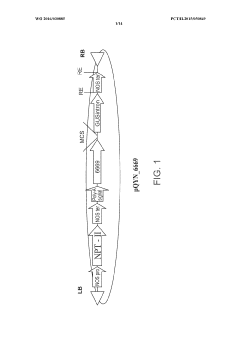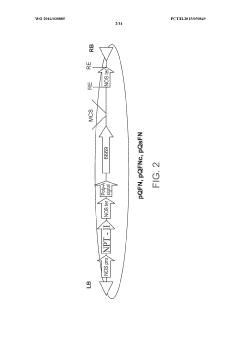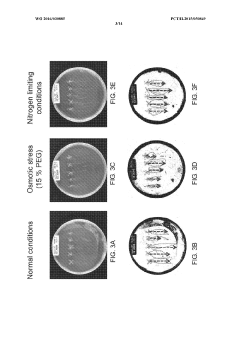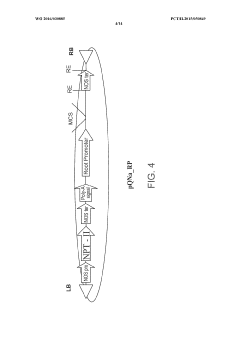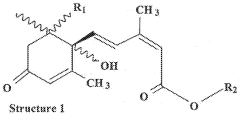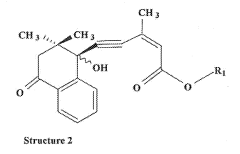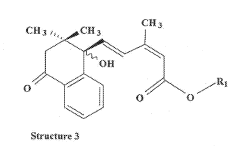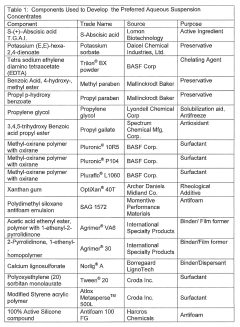How to Harness Abscisic Acid for Next-Generation Crop Varieties?
JUL 14, 20259 MIN READ
Generate Your Research Report Instantly with AI Agent
Patsnap Eureka helps you evaluate technical feasibility & market potential.
ABA Research Background
Abscisic acid (ABA) is a plant hormone that plays a crucial role in regulating various physiological processes, including seed dormancy, germination, and stress responses. The discovery of ABA dates back to the 1960s when researchers identified it as a growth inhibitor in cotton fruits. Since then, extensive research has been conducted to understand its biosynthesis, signaling pathways, and functions in plant development and stress adaptation.
ABA research has evolved significantly over the past decades, with major breakthroughs in understanding its molecular mechanisms. In the 1980s and 1990s, scientists made substantial progress in elucidating the ABA biosynthetic pathway, identifying key enzymes involved in its production. This knowledge paved the way for genetic manipulation of ABA levels in plants, opening new avenues for crop improvement.
The turn of the millennium marked a pivotal moment in ABA research with the identification of ABA receptors. The discovery of the PYR/PYL/RCAR family of ABA receptors in 2009 revolutionized our understanding of ABA signaling and provided a molecular basis for developing ABA-based agricultural technologies. This breakthrough enabled researchers to design synthetic ABA agonists and antagonists, offering new tools for modulating plant responses to environmental stresses.
In recent years, the focus of ABA research has shifted towards its application in developing climate-resilient crops. With global climate change posing significant challenges to agriculture, scientists are exploring ways to harness ABA's potential in enhancing crop tolerance to drought, salinity, and extreme temperatures. Advanced genomic and molecular breeding techniques have facilitated the development of crop varieties with optimized ABA responses, leading to improved stress tolerance and water use efficiency.
The advent of CRISPR-Cas9 gene editing technology has further accelerated ABA research, allowing precise modification of ABA-related genes in crop plants. This has enabled researchers to fine-tune ABA signaling pathways and create novel crop varieties with enhanced stress resilience. Additionally, the integration of high-throughput phenotyping and omics technologies has provided unprecedented insights into the complex regulatory networks governed by ABA, facilitating a systems-level understanding of plant stress responses.
As we look towards the future of ABA research, several key areas are emerging as focal points for next-generation crop development. These include exploring the crosstalk between ABA and other plant hormones, unraveling the epigenetic regulation of ABA responses, and leveraging synthetic biology approaches to engineer novel ABA-based traits. The potential of ABA in improving crop yield stability under adverse environmental conditions positions it as a critical component in addressing global food security challenges in the face of climate change.
ABA research has evolved significantly over the past decades, with major breakthroughs in understanding its molecular mechanisms. In the 1980s and 1990s, scientists made substantial progress in elucidating the ABA biosynthetic pathway, identifying key enzymes involved in its production. This knowledge paved the way for genetic manipulation of ABA levels in plants, opening new avenues for crop improvement.
The turn of the millennium marked a pivotal moment in ABA research with the identification of ABA receptors. The discovery of the PYR/PYL/RCAR family of ABA receptors in 2009 revolutionized our understanding of ABA signaling and provided a molecular basis for developing ABA-based agricultural technologies. This breakthrough enabled researchers to design synthetic ABA agonists and antagonists, offering new tools for modulating plant responses to environmental stresses.
In recent years, the focus of ABA research has shifted towards its application in developing climate-resilient crops. With global climate change posing significant challenges to agriculture, scientists are exploring ways to harness ABA's potential in enhancing crop tolerance to drought, salinity, and extreme temperatures. Advanced genomic and molecular breeding techniques have facilitated the development of crop varieties with optimized ABA responses, leading to improved stress tolerance and water use efficiency.
The advent of CRISPR-Cas9 gene editing technology has further accelerated ABA research, allowing precise modification of ABA-related genes in crop plants. This has enabled researchers to fine-tune ABA signaling pathways and create novel crop varieties with enhanced stress resilience. Additionally, the integration of high-throughput phenotyping and omics technologies has provided unprecedented insights into the complex regulatory networks governed by ABA, facilitating a systems-level understanding of plant stress responses.
As we look towards the future of ABA research, several key areas are emerging as focal points for next-generation crop development. These include exploring the crosstalk between ABA and other plant hormones, unraveling the epigenetic regulation of ABA responses, and leveraging synthetic biology approaches to engineer novel ABA-based traits. The potential of ABA in improving crop yield stability under adverse environmental conditions positions it as a critical component in addressing global food security challenges in the face of climate change.
Crop Stress Tolerance Needs
The increasing frequency and severity of environmental stresses, such as drought, salinity, and extreme temperatures, pose significant challenges to global food security. As climate change continues to exacerbate these issues, there is an urgent need for crop varieties with enhanced stress tolerance. Traditional breeding methods have made progress in developing stress-resistant crops, but the pace of improvement has not kept up with the rapidly changing environmental conditions.
Abscisic acid (ABA) plays a crucial role in plant stress responses, making it a promising target for developing next-generation crop varieties with improved stress tolerance. ABA is a phytohormone that regulates various physiological processes, including seed dormancy, germination, and stomatal closure. During stress conditions, ABA levels increase, triggering adaptive responses that help plants survive adverse environments.
One of the primary needs in harnessing ABA for crop improvement is to enhance drought tolerance. Water scarcity is a major limiting factor in agricultural productivity worldwide, and developing crops that can maintain yield under water-limited conditions is essential. ABA-mediated responses, such as stomatal closure and osmotic adjustment, are key mechanisms that plants use to cope with drought stress. By manipulating ABA signaling pathways or enhancing ABA biosynthesis, researchers aim to develop crops that can more effectively conserve water and maintain growth under drought conditions.
Another critical area of focus is improving salt tolerance in crops. Soil salinization affects a significant portion of arable land globally, reducing crop yields and limiting agricultural expansion. ABA plays a vital role in salt stress responses by regulating ion homeostasis and osmotic adjustment. Developing crops with enhanced ABA-mediated salt tolerance mechanisms could help expand agriculture into marginal lands and improve yields in salt-affected areas.
Temperature stress, both heat and cold, is another major challenge that requires attention in crop improvement efforts. ABA is involved in temperature stress responses, including the regulation of heat shock proteins and cold-responsive genes. As extreme temperature events become more frequent due to climate change, developing crops with improved temperature stress tolerance through ABA-mediated mechanisms is crucial for maintaining agricultural productivity.
Furthermore, there is a need to address the trade-offs between stress tolerance and crop yield. While ABA-mediated stress responses are essential for plant survival, they can also negatively impact growth and productivity under non-stress conditions. Developing crops with fine-tuned ABA responses that balance stress tolerance and yield potential is a key challenge that researchers must overcome to create truly resilient and productive crop varieties.
Abscisic acid (ABA) plays a crucial role in plant stress responses, making it a promising target for developing next-generation crop varieties with improved stress tolerance. ABA is a phytohormone that regulates various physiological processes, including seed dormancy, germination, and stomatal closure. During stress conditions, ABA levels increase, triggering adaptive responses that help plants survive adverse environments.
One of the primary needs in harnessing ABA for crop improvement is to enhance drought tolerance. Water scarcity is a major limiting factor in agricultural productivity worldwide, and developing crops that can maintain yield under water-limited conditions is essential. ABA-mediated responses, such as stomatal closure and osmotic adjustment, are key mechanisms that plants use to cope with drought stress. By manipulating ABA signaling pathways or enhancing ABA biosynthesis, researchers aim to develop crops that can more effectively conserve water and maintain growth under drought conditions.
Another critical area of focus is improving salt tolerance in crops. Soil salinization affects a significant portion of arable land globally, reducing crop yields and limiting agricultural expansion. ABA plays a vital role in salt stress responses by regulating ion homeostasis and osmotic adjustment. Developing crops with enhanced ABA-mediated salt tolerance mechanisms could help expand agriculture into marginal lands and improve yields in salt-affected areas.
Temperature stress, both heat and cold, is another major challenge that requires attention in crop improvement efforts. ABA is involved in temperature stress responses, including the regulation of heat shock proteins and cold-responsive genes. As extreme temperature events become more frequent due to climate change, developing crops with improved temperature stress tolerance through ABA-mediated mechanisms is crucial for maintaining agricultural productivity.
Furthermore, there is a need to address the trade-offs between stress tolerance and crop yield. While ABA-mediated stress responses are essential for plant survival, they can also negatively impact growth and productivity under non-stress conditions. Developing crops with fine-tuned ABA responses that balance stress tolerance and yield potential is a key challenge that researchers must overcome to create truly resilient and productive crop varieties.
ABA Signaling Challenges
Despite the significant progress made in understanding abscisic acid (ABA) signaling, several challenges persist in harnessing its full potential for developing next-generation crop varieties. One of the primary obstacles is the complexity of the ABA signaling network, which involves numerous components and intricate feedback mechanisms. This complexity makes it difficult to predict the precise outcomes of genetic modifications aimed at enhancing ABA responses in crops.
Another challenge lies in the pleiotropic effects of ABA signaling. While ABA plays a crucial role in stress responses, it also influences various developmental processes, including seed dormancy, germination, and senescence. Manipulating ABA signaling to improve stress tolerance may inadvertently affect other important agronomic traits, potentially leading to undesired trade-offs in crop performance.
The tissue-specific and temporal regulation of ABA signaling presents an additional hurdle. Different plant tissues and developmental stages exhibit varying sensitivities to ABA, and the optimal modulation of ABA responses may differ depending on the specific stress conditions and growth phases. Developing strategies to fine-tune ABA signaling in a context-dependent manner remains a significant challenge.
Furthermore, the interaction between ABA signaling and other phytohormone pathways adds another layer of complexity. Cross-talk between ABA and hormones such as auxins, cytokinins, and ethylene can influence plant responses to stress and development. Unraveling these intricate interactions and leveraging them for crop improvement requires a comprehensive understanding of hormone signaling networks.
The genetic diversity in ABA signaling components among different crop species and varieties also poses a challenge. Variations in ABA receptors, downstream signaling elements, and transcription factors can lead to differential responses to ABA across genotypes. This diversity necessitates the development of tailored approaches for manipulating ABA signaling in specific crop varieties.
Lastly, the environmental dependency of ABA signaling presents a significant obstacle. The effectiveness of ABA-mediated stress responses can vary depending on factors such as temperature, humidity, and soil conditions. Developing crop varieties with robust and stable ABA-mediated stress tolerance across diverse environmental conditions remains a formidable challenge in agricultural biotechnology.
Another challenge lies in the pleiotropic effects of ABA signaling. While ABA plays a crucial role in stress responses, it also influences various developmental processes, including seed dormancy, germination, and senescence. Manipulating ABA signaling to improve stress tolerance may inadvertently affect other important agronomic traits, potentially leading to undesired trade-offs in crop performance.
The tissue-specific and temporal regulation of ABA signaling presents an additional hurdle. Different plant tissues and developmental stages exhibit varying sensitivities to ABA, and the optimal modulation of ABA responses may differ depending on the specific stress conditions and growth phases. Developing strategies to fine-tune ABA signaling in a context-dependent manner remains a significant challenge.
Furthermore, the interaction between ABA signaling and other phytohormone pathways adds another layer of complexity. Cross-talk between ABA and hormones such as auxins, cytokinins, and ethylene can influence plant responses to stress and development. Unraveling these intricate interactions and leveraging them for crop improvement requires a comprehensive understanding of hormone signaling networks.
The genetic diversity in ABA signaling components among different crop species and varieties also poses a challenge. Variations in ABA receptors, downstream signaling elements, and transcription factors can lead to differential responses to ABA across genotypes. This diversity necessitates the development of tailored approaches for manipulating ABA signaling in specific crop varieties.
Lastly, the environmental dependency of ABA signaling presents a significant obstacle. The effectiveness of ABA-mediated stress responses can vary depending on factors such as temperature, humidity, and soil conditions. Developing crop varieties with robust and stable ABA-mediated stress tolerance across diverse environmental conditions remains a formidable challenge in agricultural biotechnology.
Current ABA Applications
01 Synthesis and production of abscisic acid
Various methods for synthesizing and producing abscisic acid, including chemical synthesis, biosynthesis, and extraction from plant sources. These processes aim to efficiently produce abscisic acid for use in agricultural and research applications.- Synthesis and production of abscisic acid: Methods for synthesizing and producing abscisic acid, including chemical synthesis routes and biotechnological approaches using microorganisms or plant cell cultures. These techniques aim to improve the efficiency and yield of abscisic acid production for various applications.
- Agricultural applications of abscisic acid: Use of abscisic acid in agriculture for various purposes, such as regulating plant growth, improving stress tolerance, and enhancing crop yield. Applications include seed treatment, foliar sprays, and soil amendments to modulate plant responses to environmental conditions.
- Abscisic acid analogs and derivatives: Development and use of abscisic acid analogs and derivatives with enhanced stability, bioactivity, or specificity. These compounds may offer improved performance in various applications or provide new functionalities compared to natural abscisic acid.
- Formulations and compositions containing abscisic acid: Preparation of formulations and compositions incorporating abscisic acid for specific applications. These may include stabilized forms, controlled-release formulations, or combinations with other active ingredients to enhance efficacy or broaden the range of effects.
- Detection and quantification methods for abscisic acid: Development of analytical techniques for detecting and quantifying abscisic acid in various biological samples. These methods may include immunoassays, chromatographic techniques, or biosensors to measure abscisic acid levels in plants, seeds, or other materials.
02 Agricultural applications of abscisic acid
Use of abscisic acid in agriculture for various purposes, such as regulating plant growth, improving stress tolerance, and enhancing crop yield. Applications include seed treatment, foliar sprays, and soil amendments to improve plant performance under different environmental conditions.Expand Specific Solutions03 Abscisic acid analogs and derivatives
Development and use of abscisic acid analogs and derivatives with enhanced stability, bioactivity, or specificity. These modified compounds aim to improve the efficacy and applicability of abscisic acid in various fields, including agriculture and biotechnology.Expand Specific Solutions04 Abscisic acid in plant stress response
Investigation of abscisic acid's role in plant stress responses, including drought, salinity, and temperature stress. Research focuses on understanding the signaling pathways and molecular mechanisms involved in abscisic acid-mediated stress tolerance.Expand Specific Solutions05 Formulations and delivery systems for abscisic acid
Development of various formulations and delivery systems for abscisic acid to improve its stability, bioavailability, and efficacy in different applications. This includes encapsulation techniques, controlled-release formulations, and novel carrier systems.Expand Specific Solutions
ABA Research Leaders
The development of abscisic acid (ABA) technology for next-generation crop varieties is in an early growth stage, with significant potential for market expansion. The global market for ABA-related crop solutions is projected to grow substantially as agriculture faces increasing environmental challenges. While the technology is still evolving, several key players are making strides in research and development. Companies like Valent BioSciences Corp., Performance Plants, Inc., and Syngenta Crop Protection AG are at the forefront, leveraging their expertise in agricultural biotechnology. Academic institutions such as China Agricultural University and the University of California are also contributing significantly to advancing ABA research. The competitive landscape is characterized by a mix of established agrochemical companies and innovative startups, all vying to develop commercially viable ABA-based crop enhancement solutions.
Valent BioSciences Corp.
Technical Solution: Valent BioSciences Corp. has developed a proprietary ABA formulation called VBC-30151, which is a stable S-isomer of abscisic acid. This formulation is designed to enhance crop stress tolerance and improve fruit quality. The company has conducted extensive field trials demonstrating the efficacy of VBC-30151 in various crops, including grapes, cherries, and walnuts. Their approach involves precise timing and application methods to optimize ABA's effects on plant physiology, resulting in improved water use efficiency and fruit characteristics[1][3].
Strengths: Proven efficacy in commercial crops, stable formulation. Weaknesses: May require precise application timing, potential cost considerations for large-scale use.
Performance Plants, Inc.
Technical Solution: Performance Plants, Inc. has developed a gene technology platform called Yield Protection Technology (YPT) that enhances plants' natural ability to cope with drought stress by modulating ABA signaling pathways. Their approach involves identifying and modifying key genes in the ABA biosynthesis and response pathways to create drought-tolerant crop varieties. The company has successfully applied this technology to crops such as canola, corn, and soybean, demonstrating significant yield improvements under water-limited conditions[2][4].
Strengths: Genetic approach allows for inheritable traits, applicable to multiple crop species. Weaknesses: Regulatory hurdles for genetically modified crops, potential public perception issues.
Key ABA Innovations
Isolated polynucleotides and polypeptides, and methods of using same for increasing plant yield and/or agricultural characteristics
PatentWO2016030885A1
Innovation
- Expression of specific exogenous polynucleotides encoding polypeptides in plants to enhance nitrogen use efficiency, biomass, growth rate, oil content, fiber quality, and abiotic stress tolerance, using nucleic acid constructs and promoters to regulate gene expression and improve plant traits.
Novel plant growth regulator compostions, methods of preparation and use therof
PatentWO2013033316A1
Innovation
- Development of an aqueous suspension concentrate formulation with S-(+)-Abscisic acid micro particles, stabilized with non-ionic polymeric surfactants and other additives, which enhances solubility, stability, and environmental safety, allowing for higher active ingredient concentrations and versatile application methods.
ABA Regulatory Framework
The ABA regulatory framework plays a crucial role in harnessing abscisic acid (ABA) for the development of next-generation crop varieties. This framework encompasses the complex network of genes, proteins, and signaling pathways that control ABA biosynthesis, perception, and response in plants.
At the core of the ABA regulatory framework are the ABA receptors, which include the PYR/PYL/RCAR family of proteins. These receptors form the initial point of ABA perception and are essential for triggering downstream signaling cascades. Upon binding to ABA, these receptors undergo conformational changes that enable them to interact with and inhibit protein phosphatases, particularly PP2C family members.
The inhibition of PP2C phosphatases is a critical step in the ABA signaling pathway. In the absence of ABA, PP2C proteins actively suppress the activity of SnRK2 protein kinases, which are positive regulators of ABA responses. When ABA is present and PP2C activity is inhibited, SnRK2 kinases become activated and phosphorylate various downstream targets, including transcription factors and ion channels.
Transcription factors play a pivotal role in the ABA regulatory framework by modulating the expression of ABA-responsive genes. Key transcription factor families involved in ABA signaling include the AREB/ABF, MYC, and DREB proteins. These transcription factors bind to specific DNA sequences in the promoter regions of ABA-responsive genes, thereby regulating their expression in response to ABA-mediated signals.
The ABA regulatory framework also incorporates various feedback mechanisms and crosstalk with other hormonal pathways. For instance, ABA signaling can influence the biosynthesis and signaling of other plant hormones such as ethylene and jasmonic acid, creating a complex web of interactions that fine-tune plant responses to environmental stresses.
Understanding and manipulating the ABA regulatory framework is essential for developing next-generation crop varieties with enhanced stress tolerance. By targeting specific components of this framework, such as ABA receptors, protein phosphatases, or transcription factors, researchers can potentially engineer crops with improved drought resistance, salt tolerance, and overall yield stability under adverse conditions.
Recent advances in genome editing technologies, such as CRISPR-Cas9, have opened up new possibilities for precise manipulation of the ABA regulatory framework in crop plants. These tools allow for targeted modifications of key genes involved in ABA signaling, potentially leading to the development of crops with optimized ABA responses tailored to specific environmental challenges.
At the core of the ABA regulatory framework are the ABA receptors, which include the PYR/PYL/RCAR family of proteins. These receptors form the initial point of ABA perception and are essential for triggering downstream signaling cascades. Upon binding to ABA, these receptors undergo conformational changes that enable them to interact with and inhibit protein phosphatases, particularly PP2C family members.
The inhibition of PP2C phosphatases is a critical step in the ABA signaling pathway. In the absence of ABA, PP2C proteins actively suppress the activity of SnRK2 protein kinases, which are positive regulators of ABA responses. When ABA is present and PP2C activity is inhibited, SnRK2 kinases become activated and phosphorylate various downstream targets, including transcription factors and ion channels.
Transcription factors play a pivotal role in the ABA regulatory framework by modulating the expression of ABA-responsive genes. Key transcription factor families involved in ABA signaling include the AREB/ABF, MYC, and DREB proteins. These transcription factors bind to specific DNA sequences in the promoter regions of ABA-responsive genes, thereby regulating their expression in response to ABA-mediated signals.
The ABA regulatory framework also incorporates various feedback mechanisms and crosstalk with other hormonal pathways. For instance, ABA signaling can influence the biosynthesis and signaling of other plant hormones such as ethylene and jasmonic acid, creating a complex web of interactions that fine-tune plant responses to environmental stresses.
Understanding and manipulating the ABA regulatory framework is essential for developing next-generation crop varieties with enhanced stress tolerance. By targeting specific components of this framework, such as ABA receptors, protein phosphatases, or transcription factors, researchers can potentially engineer crops with improved drought resistance, salt tolerance, and overall yield stability under adverse conditions.
Recent advances in genome editing technologies, such as CRISPR-Cas9, have opened up new possibilities for precise manipulation of the ABA regulatory framework in crop plants. These tools allow for targeted modifications of key genes involved in ABA signaling, potentially leading to the development of crops with optimized ABA responses tailored to specific environmental challenges.
ABA Environmental Impact
The environmental impact of abscisic acid (ABA) in next-generation crop varieties is a critical consideration for sustainable agriculture. ABA plays a crucial role in plant stress responses, particularly in drought tolerance, making it a key target for crop improvement strategies. However, its widespread application in agriculture raises important questions about potential ecological consequences.
One of the primary environmental benefits of ABA-enhanced crops is their improved water use efficiency. By optimizing plant responses to water stress, these varieties can maintain productivity with reduced irrigation, potentially conserving water resources in agriculture. This is particularly significant in regions facing water scarcity or irregular rainfall patterns due to climate change.
However, the introduction of ABA-enhanced crops may also lead to unintended ecological effects. Altered ABA signaling in plants could influence their interactions with beneficial soil microorganisms, potentially disrupting established symbiotic relationships. This could have cascading effects on soil health and nutrient cycling in agricultural ecosystems.
Furthermore, the increased drought tolerance of ABA-enhanced crops might enable agricultural expansion into marginal lands previously unsuitable for cultivation. While this could boost food production, it also risks habitat encroachment and biodiversity loss if not carefully managed.
The impact on local and regional water cycles is another consideration. If ABA-enhanced crops significantly reduce water uptake from soil, it could alter soil moisture levels and potentially affect groundwater recharge rates. This might have implications for surrounding ecosystems and water availability for other plant species.
Pest and disease dynamics could also be influenced by widespread adoption of ABA-enhanced crops. Changes in plant physiology might alter their susceptibility to certain pests or pathogens, potentially leading to shifts in pest populations or the emergence of new agricultural threats.
From a broader perspective, the development of ABA-enhanced crops could contribute to agricultural resilience in the face of climate change. By improving crop performance under drought conditions, these varieties could help stabilize food production in regions experiencing increasing aridity or unpredictable weather patterns.
However, it is crucial to conduct comprehensive environmental impact assessments before large-scale deployment of ABA-enhanced crops. Long-term studies are needed to evaluate potential effects on biodiversity, soil health, and ecosystem services. Additionally, the potential for gene flow to wild relatives and its ecological consequences should be carefully examined.
One of the primary environmental benefits of ABA-enhanced crops is their improved water use efficiency. By optimizing plant responses to water stress, these varieties can maintain productivity with reduced irrigation, potentially conserving water resources in agriculture. This is particularly significant in regions facing water scarcity or irregular rainfall patterns due to climate change.
However, the introduction of ABA-enhanced crops may also lead to unintended ecological effects. Altered ABA signaling in plants could influence their interactions with beneficial soil microorganisms, potentially disrupting established symbiotic relationships. This could have cascading effects on soil health and nutrient cycling in agricultural ecosystems.
Furthermore, the increased drought tolerance of ABA-enhanced crops might enable agricultural expansion into marginal lands previously unsuitable for cultivation. While this could boost food production, it also risks habitat encroachment and biodiversity loss if not carefully managed.
The impact on local and regional water cycles is another consideration. If ABA-enhanced crops significantly reduce water uptake from soil, it could alter soil moisture levels and potentially affect groundwater recharge rates. This might have implications for surrounding ecosystems and water availability for other plant species.
Pest and disease dynamics could also be influenced by widespread adoption of ABA-enhanced crops. Changes in plant physiology might alter their susceptibility to certain pests or pathogens, potentially leading to shifts in pest populations or the emergence of new agricultural threats.
From a broader perspective, the development of ABA-enhanced crops could contribute to agricultural resilience in the face of climate change. By improving crop performance under drought conditions, these varieties could help stabilize food production in regions experiencing increasing aridity or unpredictable weather patterns.
However, it is crucial to conduct comprehensive environmental impact assessments before large-scale deployment of ABA-enhanced crops. Long-term studies are needed to evaluate potential effects on biodiversity, soil health, and ecosystem services. Additionally, the potential for gene flow to wild relatives and its ecological consequences should be carefully examined.
Unlock deeper insights with Patsnap Eureka Quick Research — get a full tech report to explore trends and direct your research. Try now!
Generate Your Research Report Instantly with AI Agent
Supercharge your innovation with Patsnap Eureka AI Agent Platform!
